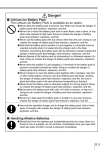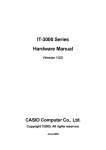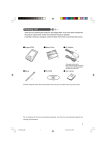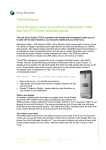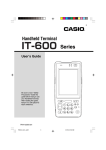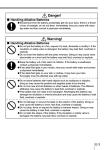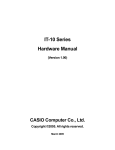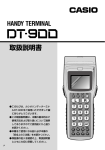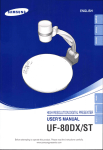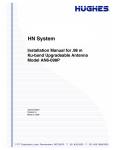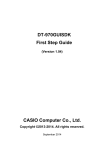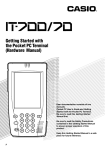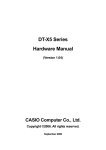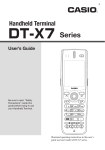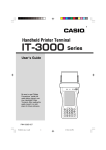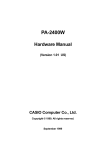Download Casio DT-930 User's Manual
Transcript
Printed in China
AB0302-046021D
6-2, Hon-machi 1-chome
Shibuya-ku, Tokyo 151-8543, Japan
CASIO COMPUTER CO., LTD.
Handheld Terminal
Series
User’s Guide
Data Collection Terminal
Data Collection Terminal
• Be sure to read "Safety Precautions"
inside this guide before trying to use
your Handheld Terminal. After reading
this guide, keep it in a safe place for
future reference.
PN430041-001
C-2
_irbqllqe !"#$_äìÉíççíÜ=pfdK=fåÅK !"#$%&'()*+,
!"#$%
BLUETOOTH is a registered trademark owned by Bluetooth SIG. Inc. and licensed to
CASIO COMPUTER CO., LTD.
E-2
Safety Precautions
Congratulations upon your selection of this CASIO Product. Be sure to read
the following Safety Precautions before trying to use it for the first time.
Keep this manual in a handy place for future reference.
Markings and Symbols
The following are the meanings of the markings and symbols
used in these Safety Precautions to warn you against the
possibility of personal injury and/or material damage or loss
to you and others. Take a few moments to become familiar
with these markings and symbols so you can avoid future
problems.
Danger!
This symbol indicates information that, if ignored or
applied incorrectly, creates the danger of death or serious
personal injury.
Warning!
This symbol indicates information that, if ignored or
applied incorrectly, can create the possibility of death or
serious personal injury.
Caution!
This symbol indicates information that, if ignored or
applied incorrectly, can create the possibility of personal
injury or material damage.
Marking examples
A triangular shape indicates you should exercise
caution. The symbol shown here indicates you
should take care to avoid breakage.
A circle indicates something you should not do.
This symbol indicates you should not try to
take something apart.
A black circle indicates something you must
do. This symbol indicates you should unplug
power cord.
E-3
Danger!
■ Lithium-ion Battery Pack
The Lithium-ion Battery Pack is available as an option.
● Never allow the battery pack to become wet. Water can create the danger of
battery pack heat emission, explosion, and fire.
● Never use or leave the battery pack next to open flame, near a stove, or any
other area exposed to high heat. Doing so creates the danger of battery
pack heat emission, explosion, and fire.
● Never use the battery pack with any device other than this unit. Doing so can
creates the danger of battery pack heat emission, explosion, and fire.
● Note that the battery pack’s positive (+) and negative (–) terminals must be
oriented correctly when it is loaded into the charger unit or the Data
Collector. Connecting the battery pack with its terminals reversed creates the
danger of battery pack fluid leakage, heat emission, explosion, and fire.
● Never dispose of the battery pack by incinerating it or otherwise expose it to
heat. Doing so creates the danger of battery pack heat emission, explosion,
and fire.
● Never allow the positive (+) and negative (–) terminals of the battery pack to
become connected (shorted) by metal. Doing so creates the danger of
battery pack heat emission, explosion, and fire.
● Never transport or store the battery pack together with a necklace, hair pins
or other metal objects. Doing so can short battery pack terminals, creating
the danger of battery pack heat emission, explosion, and fire. Be sure to
place the battery pack in its case whenever transporting or storing it.
● Never throw the battery pack or otherwise subject it to strong impact. Doing
so creates the danger of battery pack heat emission, explosion, and fire.
● Never pierce the battery pack with nails, hit it with a hammer, or step on it.
Doing so can create the danger of battery pack heat emission, explosion,
and fire.
● Never try to take apart the battery pack or modify it in any way. Doing so
creates the danger of battery pack heat emission, explosion, and fire.
● Use only the specified charger unit to charge the battery pack. Use of other
types of charger units creates the danger of battery pack heat emission,
explosion, and fire.
■ Handling Alkaline Batteries
● Should fluid from the alkaline batteries accidentally get into your eyes, there
is a threat of loss of eyesight, do not rub them. Immediately rinse your eyes
with clean tap water and then consult a physician immediately.
E-4
Warning!
■ Disassembly and Modification
● Never try to disassemble or modify the unit in any way. High voltage inside
creates the danger of electrical shock.
■ Interior Parts and Components
● Never touch interior high-voltage parts or components. Doing so creates the
danger of electrical shock.
■ Abnormal Conditions
● Should the unit become hot or start to emit smoke or a strange odor,
immediately turn off the power and contact your original dealer or an
authorized CASIO service provider. Continued use creates the danger of fire
and electrical shock.
■ Foreign Objects
● Should any foreign matter ever get into the unit, immediately turn off the
power and contact your original dealer or an authorized CASIO service
provider. Continued use creates the danger of fire and electrical shock.
■ Dropping and Damage
● Should you drop the unit and damage it, immediately turn off the power and
contact your original dealer or an authorized CASIO service provider.
Continued use creates the danger of fire and electrical shock.
■ Moisture
● Keep the unit away from vases, planters, cups, glasses and other containers
of liquid. Also keep it away from metal. Water and metal getting into the unit
creates the danger of fire and electrical shock.
■ Laser Beam
● Never look directly into the laser beam. Doing so can cause serious eye
damage.
E-5
Warning!
■ Interference with the Operation of Other Equipment
(Using Wireless Communication)
● Keep your Handheld Terminal at least 22 centimeters (8' 1/10") away from
anyone wearing a pacemaker. Radio waves emitted by the Handheld
Terminal can affect the operation of a pacemaker.
● In order to protect someone wearing a pacemaker from the risk of
unintentional interference, turn off the Handheld Terminal before boarding a
crowded train or entering any other crowded area.
■ Handling Alkaline Batteries
● Do not put the battery in a fire, expose it to heat, dismantle or modify it. If the
insulation or safety valve is damaged, the battery may leak fluid, overheat or
explode.
● Do not insert the battery with the poles reversed. Doing so may cause some
abnormality or a short and the battery may leak fluid, overheat or explode.
● Keep the battery out of the reach of children. If the battery is swallowed,
contact a physician immediately.
● If the alkali fluid gets in your mouth, rinse your mouth with water and contact
a physician immediately.
● If the alkali fluid gets on your skin or clothes, it may burn your skin,
thoroughly rinse the affected area with tap water.
● Do not store batteries with metal objects such as necklaces or hairpins,
doing so may cause the positive and negative poles to be shorted.
● Do not mix new and old batteries or other makes of batteries. The different
attributes may cause the battery to leak fluid, overheat or explode.
● This battery was not made to be recharged. Recharging this battery may
damage the insulation or internal structure and may cause the battery to leak
fluid, overheat or explode.
● Do not damage or remove the label on the exterior of the battery. Doing so
may cause the battery to short, leak fluid, overheat or explode.
● Do not drop, throw or expose the battery to extreme impact. Doing so may
cause the battery to leak fluid, overheat or explode.
● Do not alter the shape of the battery. If the insulation or safety valve is
damaged, the battery may leak fluid, overheat or explode.
E-6
Warning!
■ Handling the Coin Type Lithium Battery
● Do not recharge coin type lithium battery. Doing so may cause it to leak fluid,
overheat, explode or burst into flames.
● Do not put the coin type lithium battery in open flame, or apply solder directly
to the coin type lithium battery. Doing so may cause it to leak fluid, overheat,
explode or burst into flames.
● Do not use the coin type lithium battery with the positive and negative poles
reversed. Do not store it with metal objects such as necklaces or hairpins,
doing so may cause the positive and negative poles to be shorted.
● Keep the coin type lithium battery out of the reach of children. If it is
swallowed, contact a physician immediately.
● If the alkali fluid gets in your eye, rinse the eye with water and contact a
physician immediately.
● If the alkali fluid gets in your mouth, rinse your mouth with water and contact
a physician immediately.
● If the coin type lithium battery leaks fluid or emits a strange smell,
immediately remove it from near heat or flames. Burning may cause it to
explode or burst into flames.
● When storing or disposing of the coin type lithium battery, cover the
terminals with tape to insulate them. Mixing them with other batteries or
metal objects may cause the coin type lithium battery to short, leak fluid,
overheat, explode or burst into flames.
■ Lithium-ion Battery Pack
● Do not put a battery pack in microwave ovens or pressure cookers. Doing so
may cause the battery pack to overheat, explode or burst into flames.
● Do not use a battery pack that smells strange, is overheating, is a strange
color, or is a strange shape. Doing so may cause the battery pack to
overheat, explode or burst into flames.
● If the amount of time period the battery pack can serve becomes
considerably short, stop using it. It may indicate the possibility of a
malfunction in the battery pack. Continued charging the battery pack creates
the danger of heat emission, explosion, and fire.
● Stop charging the battery pack after the recommended time even if it is not
fully charged. Continuing to charge the battery may cause the battery pack
to overheat, explode or burst into flames.
● If the battery pack leaks fluid or emits a strange smell, remove it from near
heat or flames. Burning may cause the battery pack to explode or burst into
flames.
● Should fluid from the battery pack accidentally get into your eyes, do not rub
them. Immediately rinse your eyes with clean water such as tap water and
then consult a physician immediately.
E-7
Warning!
■ Optional Bridge Basic Cradle, Basic Cradle, Satellite Cradle
and Cradle-type Battery Charger
● Power these cradles and Cradle-type battery charger only with a power
outlet whose voltage matches that marked on the rating plate of each option.
Do not plug these options into an extension shared by other appliances.
Doing so creates the danger of fire and electrical shock.
● Avoid conditions that can cause damage or breaks in the power cord. Do not
place heavy objects on the power cord. Keep it away from sources of heat.
Any of these conditions can damage the power cord, creating the danger of
fire and electrical shock.
● Never modify, sharply bend, twist, or pull on the power cord. Doing so
creates the danger of fire and electrical shock.
● Use only the AC adaptors and chargers specified in this manual. Use of
other AC adaptor models or chargers creates the danger of fire and electrical
shock.
● Should the power cord ever become severely damaged (to the point that
wires are exposed or broken), contact your original dealer or CASIO service
provider for repair or replacement. Use of a damaged electrical cord creates
the danger of fire and electrical shock.
Caution!
■ Foreign Objects
● Take care to ensure that metal or combustible objects are not inserted into
the openings of the unit. Such objects create the danger of fire and electrical
shock.
■ Location
● Do not locate the unit on a surface that is unstable or uneven. Doing so
creates the danger of the unit falling, which can cause personal injury.
● Do not locate the unit in an area subjected to large amounts of humidity or
dust. Doing so creates the danger of fire and electrical shock.
● Do not leave the unit for long periods in a car parked in direct sunlight.
■ Heavy Objects
● Never place heavy objects on top of the unit. Doing so creates the risk of a
loss of balance and the object falling, which can cause personal injury.
E-8
Caution!
■ LCD Screen
● Never apply strong pressure to the screen or subject it to strong impact. Doing
so can crack the LCD panel glass and create the danger of personal injury.
● Should the LCD panel glass ever break, never touch the liquid inside. Doing
so can cause skin irritation and inflammation.
• Should liquid from the LCD panel accidentally get into your mouth,
immediately wash your mouth with water and then consult a physician.
• Should liquid from the LCD panel accidentally get into your eyes or onto
your skin, immediately rinse for at least 15 minutes with clean tap water
and then consult a physician.
■ Lithium-ion Battery Pack
● Never leave the battery pack in an area expose to direct sunlight, in a car
parked in direct sunlight, or any other very hot area. Doing so creates the
danger of heat emission and fire, as well as deterioration of battery pack
performance and shortening of its service life.
● Do not use the battery pack in areas where static electricity is being
generated. Doing so creates the danger of battery pack heat emission,
explosion, and fire.
● Temperature ranges for battery pack use, charging, and storage are
specified below. Temperatures outside these ranges create the danger of
deterioration of battery pack performance and shortening of its service life,
as well as fluid leakage and heat generation.
Operating Temperature: –20°C to 50°C
Charging Temperature: 0°C to 40°C
Storage Temperature: –20°C to 60°C
● Should fluid from the battery pack accidentally get onto clothing or your skin,
immediately rinse it off with clean tap water. Prolonged contact with battery
pack fluid can cause skin irritation.
● Keep the battery pack out of the reach of small children. Do not let small
children remove the battery pack from the charger unit or the unit it is
powering.
E-9
Caution!
■ Handling Alkaline Batteries
● Store batteries someplace out of direct sunlight where the temperature and
humidity are not high. Not doing so may cause the batteries to leak fluid,
overheat or explode. Also, it may cause the life and performance of the
batteries to decline.
● These batteries can be disposed of as regular garbage, however, if
applicable, follow the regulations of the local government when disposing of
these batteries.
● Immediately remove batteries when they have lost all power. Leaving the
batteries in the unit for a long time may cause the batteries to leak fluid,
overheat or explode due to gas that is generated by the batteries.
● Remove the batteries from the unit when not using the unit for an extended
period of time. The batteries may leak fluid, overheat or explode due to gas
that is generated by the batteries.
● Do not apply solder directly to the batteries. The heat may cause the
batteries to leak fluid, overheat or explode.
● Do not store the batteries in the direct sunlight or in a car on a sunny day
when it is very hot. The batteries may leak fluid, overheat or explode.
● When storing or disposing of the batteries, cover the terminals with tape to
insulate them. Mixing them with other batteries or metal objects may cause
the batteries to leak fluid, overheat or explode.
● Do not get the batteries wet. Doing so may cause the batteries to overheat.
■ Handling the Coin Type Lithium Battery
● Do not drop, expose to severe impact or alter the shape of the coin type
lithium battery. Also, do not get the battery wet. Doing so may cause it to
leak fluid, overheat or explode.
● Do not store the coin type lithium battery in the direct sunlight or in a car on a
sunny day when it is very hot. It may leak fluid, overheat or explode.
● Store the coin type lithium battery someplace out of direct sunlight where the
temperature and humidity are not high. Not doing so may cause it to leak
fluid, overheat or explode. Also, it may cause the life and performance of the
battery to decline.
● The coin type lithium battery can be disposed of following the instruction or
guide issued by your municipal office.
E-10
Caution!
■ Optional Bridge Basic Cradle, Basic Cradle, Satellite Cradle
and Cradle-type Battery Charger
● Keep the power cord away from stoves and other sources of extreme heat.
Heat can melt the insulation of the power cord and create the danger of fire
and electrical shock.
● Never pull on the power cord when unplugging it. Doing so can damage the
cord and create the danger of personal injury, fire and electrical shock.
Always hold onto the plug when unplugging it from the wall outlet.
● Never touch the plug while your hands are wet. Doing so can create the
danger of electrical shock.
● Be sure to unplug the power cord from the wall outlet before moving the
optional cradles and Cradle-type Battery Charger. Failure to do so can result
in damage to the power cord caused by pulling it, which creates the danger
of fire and electrical shock.
● Be sure to unplug the power cord from the wall outlet before cleaning the
optional cradles and Cradle-type Battery Charger.
● Be sure to turn the power OFF and unplug the power cord after use.
● Unplug the power cord from the wall outlet and clean the area around the
plugs at least once a year. If dust collects on the AC adaptor, humidity or
moisture may cause a fault in the insulation, which may result in a fire.
● The housing of the AC adaptor can become warm during normal use.
● Take normal precautions against electric shock.
Make back-up copies of all important data
Caution!
● Note that CASIO Computer Co., Ltd. shall not be liable to you or any third
party for any damages or loss caused by deletion or corruption of data due
to use of this, malfunction or repair of this unit or its peripherals, or due to
batteries going dead.
● This unit employs electronic memory to store data, which means that
memory contents can be corrupted or deleted if the power is interrupted due
to batteries going dead or incorrect battery replacement procedures. Data
cannot be recovered once it is lost or corrupted. Be sure to make back-up
copies of all important data. One way to do this is to use either one of the
Bridge Basic Cradle, Basic Cradle and Satellite Cradle to transfer data to a
computer.
E-11
Introduction
Make sure you carefully read the following information to ensure that your Handheld Terminal
is able to perform at the level for which it is designed.
Handling Precautions
• Do not throw or drop the Handheld Terminal or otherwise subject it to strong impact, which
can damage the LCD screen, interrupt program execution, corrupt memory contents, or
otherwise interfere with proper operation.
• Use only your finger or a blunt object to operate the stroke keys. Use of a sharp pointed
object can damage stroke keys and cause shorting of internal circuitry.
• Use a soft, dry cloth when cleaning the Handheld Terminal. Do not wipe with a wet cloth.
Do not use benzine, thinner, or other volatile chemicals, which can result in deformation
and deterioration of the materials used in the keys and case.
• Do not lay the Handheld Terminal down with its key panel downwards. Doing so runs the
risk of accidental key operation, which can cause malfunction.
• Never remove the main battery while Handheld Terminal power is turned ON. Doing so
can cause all data in memory to be lost.
• Sudden temperature changes can cause condensation to form on the Handheld Terminal’s
case. Operating the Handheld Terminal while condensation is present can interfere with
proper operation. Take care to avoid conditions that cause the formation of condensation. If
condensation does form, wait until it dries completely before using the Handheld Terminal.
E-12
Product description/Intended use
EU/EFTA member states intended
for use
Member states with restrictive use
EU: Austria, Belgium, Denmark, Finland, France, Germany,
Greece, Ireland, Italy, Luxembourg, The Netherlands, Portugal,
Spain, Sweden, United Kingdom, Czech Republic, Hungary,
Poland, Slovenia, Slovakia, Estonia, Latvia, Lithuania, Cyprus,
Malta
EFTA: Switzerland, Iceland, Lichtenstein, Norway
NONE
Manufacturer
Brand
CASIO COMPUTER CO.,LTD.
CASIO
Type
DT-930M50E, DT-930M51E
are tested and found to conform with the essential requirements for protection of health and
the safety of the user and any other persons and Electromagnetic Compatibility, as included
in following standards:
Standard
Issue date
EN 60950-1
EN301 489-1 v1.4.1
2001
2002-08
EN301 489-17 v1.2.1
2002-08
and are tested and found to conform with the essential radio test suites so that they
effectively use the frequency spectrum allocated to terrestrial/space radio communication
and orbital resources so to as to avoid harmful interference, as included in following
standards:
Standard
EN300 328 v1.6.1
Issue date
2004-11
and therefore comply with the essential requirements and provisions of the Directive 1999/5/
EC of the European Parliament and of the council of March 9, 1999 on Radio Equipment and
Telecommunications Terminal Equipment and the mutual recognition of their conformity and
with the provisions of Annex III (Conformity Assessment procedure referred to in article 10).
The technical documentation as required by the Conformity Assessment procedure is kept at
the following address:
Company
Address, City
Country
CASIO Europe GmbH
Bornbarch 10, D-22848 Norderstedt
Germany
Phone number
Fax number
+49(0)40-528-65-0
+49(0)40-528-65-424
Products are for distribution within
all member states of the EU.
E-13
• The contents of this manual are subject to change without notice.
• The term “Handheld Terminal” as used in this User’s Guide refers to the CASIO DT-930
Handheld Terminal unless otherwise noted.
• CASIO COMPUTER CO., LTD. assumes no responsibility for any loss or claims by third
parties which may arise from the use of this manual.
• This manual does not cover programming and the uploading of data. See the separate
manuals for details of these procedures.
Contents
Safety Precautions ............................................... E-3
Introduction ......................................................... E-12
Handling Precautions ........................................................... E-12
Unpacking ........................................................... E-16
Available Models and Options ........................... E-17
General Guide ..................................................... E-19
Power Supply ...................................................... E-20
Loading and Removing the AA (LR6)-size alkaline batteries ... E-21
Loading and Removing the Lithium-ion Battery Pack .......... E-22
Replacing the Backup Lithium Battery ................................. E-23
About the LCD Screen ........................................ E-25
Attaching the Wrist Strap ................................... E-26
To attach the wrist strap ....................................................... E-26
Keys and Their Functions .................................. E-27
Using the Bar Code Reader ............................... E-28
Performing a Bar Code Read Operation .............................. E-28
Adjusting the Laser Beam Width ......................................... E-30
Communications ................................................. E-32
IR Communication ............................................................... E-32
Bluetooth® Communication .................................................. E-33
Specifications ..................................................... E-34
Lithium-Ion Battery Pack (DT-923LIB) ................................. E-35
Using the Bridge Basic Cradle .......................... E-36
Setting up the Bridge Basic Cradle ................... E-37
Connecting without Using the AC Adaptor ........................... E-38
Mounting on a Wall .............................................................. E-39
Removing the Wall Mount Unit ............................................ E-40
HA-E60IO Bridge Basic Cradle specifications ..................... E-41
E-14
Using the Basic Cradle ....................................... E-42
General Guide ..................................................................... E-42
When You Are Using the Down-facing Reader Port Model .. E-44
Setting up the Basic Cradle ................................................. E-44
Serial Connection of Multiple Basic Cradles ........................ E-46
DIP Switch Settings ............................................................. E-46
DT-960IOE Basic Cradle Specifications .............................. E-47
Using the Satellite Cradle .................................. E-48
General Guide ..................................................................... E-48
When You Are Using the Down-facing Reader Port Model .. E-50
Setting up the Satellite Cradle ............................................. E-50
Charging the Battery Pack ................................................... E-53
Charging the Battery Pack
(charging the lithium-ion battery pack separately) .......... E-54
Serial Connection of Multiple Satellite Cradles .................... E-55
DIP Switch Settings ............................................................. E-56
DT-964IOE Satellite Cradle Specifications .......................... E-57
Using the Cradle-type Battery Charger ............ E-58
General Guide ..................................................................... E-59
When You Are Using the Down-facing Reader Port Model .. E-60
Setting up the Cradle-type Battery Charger ......................... E-60
Charging the Battery Pack
(charging the lithium-ion battery pack separately) .......... E-63
DT-969CHGE Cradle-type Battery Charger Specifications . E-65
Installing Cradles and Cradle-type Battery Charger ... E-66
To hang the cradles and charger on a wall .......................... E-66
This mark applies in EU
countries only.
CASIO Europe GmbH
Bornbarch 10, D-22848
Norderstedt, Germany
E-15
Unpacking
When unpacking the Handheld Terminal (either DT-930M50E or DT-930M51E), check
carefully that all of the items shown below are included. If anything is missing or damaged,
contact your original dealer or your nearest CASIO Service Provider.
• Handheld Terminal
(down-facing reader port)
(forward-facing reader port)
DT-930 M50E
DT-930 M51E
• AA (LR6)-size alkaline batteries
• Back-up battery (lithium)
• Wrist Strap
• User's Guide (this guide)
Handheld Terminal
Series
User’s Guide
• Be sure to read "Safety Precautions"
inside this guide before trying to
your Handheld Terminal. After reading
this guide, keep it in a safe place
future reference
P
• Desktop guides L and R for
desktop configuration
• Wall mount guides L and R for
wall mount configuration
* Be sure to remove the original guides come installed on Basic Cradle, Satellite Cradle and
Cradle-type battery Charger prior to the use with DT-930, and then install either one of the
new guides accompanied in the package, the desktop guides for desktop configuration or
the wall mount guides for wall mount configuration.
E-16
Available Models and Options
Options
Bridge Basic Cradle
HA-E60IO
Basic Cradle
Satellite Cradle
DT-960IOE
DT-964IOE
Cradle-type Battery Charger
Lithium-ion Battery Pack
DT-969CHGE
DT-923LIB
Cables
Wall Mount Unit for Bridge Basic Cradle
DT-930 M50E
DT-930 M51E
E-17
E-18
AC Adaptor for Bridge Basic Cradle
AC Adaptor for Basic Cradle
AD-S15050AE
DT-9020 ADP-GS
DT-9020ADP-US
AC adaptor for Satellite Cradle
AC adaptor for Cradle-type Battery Charger
AD-S42120AE
DT-9020 ADP-GS
DT-9020ADP-US
RS-232Ccable
DT-782RSC
Cross-cable for Basic Cradle
14Pin-25Pin
(Male)
RS-232Ccable
DT-783RSC
Cross-cable for Basic Cradle
14Pin-25Pin
(female)
RS-232Ccable
DT-787AX
Cross-cable for Basic Cradle
14Pin-9Pin
(female)
RS-232Ccable
DT-881RSC
Straight cable for Satellite Cradle
For modem
connection
RS-232Ccable
DT-882RSC
Cross-cable for connecting Satellite Cradle
to personal computer
25Pin (male)
RS-232Ccable
DT-883RSC
Cross-cable for connecting Satellite Cradle
to personal computer
25Pin
(female)
RS-232Ccable
DT-887AX/AXA
Cross-cable for connecting Satellite Cradle
to personal computer
9Pin
(female)
RS-485cable
DT-788RSC
6-6 pin modular cable or daisy-chaining
Basic Cradle
RS-422cable
DT-888RSC
For daisy-chaining Satellite Cradle
USB Cable
DT-380USB
Bridge Basic Cradle to personal computer
General Guide
Left side
Front
Right side
Back
1
1
8
2
9
6
3
4
4
10
5
12
7
11
7
Bottom
7
14
13
7
1
Reader port
Emits a laser for bar code reading.
2
Read indicator
Indicates the status of the read operation: green for a successful
read, red when the read is no good.
3
LCD screen
Displays various data when a program is being run.
4
Trigger keys
Executes the bar code read operation.
5
Stroke keys
A total of 26 keys are provided to turn power ON and OFF and for
other operations.
6
Reset switch (inside the hole)
Use a paper clip or other thin object to press the RESET switch
located inside the hole.
7
Wrist strap hook
Used to install the wrist strap.
8
Laser warning label
Class 2 laser warning label.
9
Buzzer
Outputs operation confirmation tones. Take care to avoid blocking
the buzzer holes and reducing output sound volume. Never insert
any thin, pointed object into the buzzer holes. Doing so can cause
malfunction.
10 Back-up battery compartment
Holds memory backup lithium battery.
11 Main battery compartment
Holds main batteries.
12 Main battery compartment lock Locks the main battery compartment cover in place. Handheld
Terminal power is automatically cut if the cover is removed.
13 Power Contacts
These terminals are used to supply power from either Bridge Basic
Cradle, Basic Cradle, Satellite Cradle, or Cradle-type Battery Charger.
14 IR port
This port is for IR communication with another DT-930 unit or with
one of the optional cradles.
E-19
Power Supply
The Handheld Terminal has both operating power supply provided by either two
AA (LR6)-size alkaline batteries or lithium-ion battery pack, and memory backup
power supply provided by lithium battery. In this manual, the words "main battery"
refer to both alkaline batteries and the lithium-ion battery pack, unless otherwise
noted.
Low main battery power is indicated when the low voltage message appears on the LCD
screen. Replace the main battery or charge the battery pack as soon as possible after the
low voltage message appears.
[Caution]
■ For Important Data
• Never remove both the main battery and backup battery at the same
time. Doing so causes all program settings and data in Handheld
Terminal memory to be lost or changed. Data cannot be recovered
once it is lost or corrupted. Be sure to make back-up copies of all
important data. One way to do this is to use one of the optional cradles
to transfer data to a computer.
Important!
E-20
• Never remove the main battery from the Handheld Terminal while the
power is turned ON. Doing so can cause data in Handheld Terminal
memory to be lost. Before you remove the battery, be sure to turn the
Handheld Terminal OFF.
• Use only two AA (LR6)-size alkaline batteries or the dedicated lithiumion battery pack.
• The lithium-ion battery pack discharges naturally during its
transportation from the factory to an end-user. Be sure to charge the
battery pack before you use it for the first time.
• Never allow the terminals of the lithium-ion battery to become shorted.
Doing so creates the danger of malfunction. Be sure to keep the
battery pack in its case when transporting or storing it.
• Repeat charging of the lithium-ion battery pack gradually shortens its
ability to recharge. If you find that a fully charged battery pack
provides only little operation time, it probably means you need a new
battery pack.
• Whenever you do not plan to use the Handheld Terminal for a long
time, load two new alkaline batteries or a fully charged battery pack
into the Handheld Terminal to protect against power failure during nonuse. Also, load new batteries or a fully charged battery pack before
using the Handheld Terminal after a long period of non-use.
• If the battery pack has been left over unused for a long period of time,
the capacity remained decreases due to spontaneous discharge or
chemical decomposition by the battery pack itself. If the battery pack
fails to hold its operating duration after it has been fully charged,
replace it with a new one. The battery pack may reach the end of its
service life.
Loading and Removing the AA (LR6)-size alkaline batteries
Important!
When you load the AA (LR6)-size alkaline batteries, make sure that
their positive (+) and negative (–) ends are facing the correct
directions.
Loading the alkaline batteries
1
2
3
Slide the main battery compartment cover
lock to the FREE position and remove the
cover.
Load two new AA (LR6)-size alkaline batteries
into the main battery compartment, making
sure that they face the directions shown in the
figure.
Attach the battery compartment cover to the
Handheld Terminal and slide the main battery
compartment cover lock to the LOCK position.
Removing the alkaline batteries
Remove the alkaline batteries following the loading procedure in reverse.
Be sure to turn the Handheld Terminal OFF before you do this.
E-21
Power Supply
Loading and Removing the Lithium-ion Battery Pack
Loading the Lithium-ion Battery Pack
1
2
3
Slide the main battery compartment cover
lock to the FREE position and remove the
cover.
Load a lithium-ion battery pack into the main
battery compartment in the direction shown in
the figure.
Load the battery while sliding it in with the ▲
mark on the lithium-ion battery pack aligned
with the ▼ mark in the main battery
compartment.
Attach the battery compartment cover to the
Handheld Terminal and slide the main battery
compartment cover lock to the LOCK position.
Removing the Lithium-ion Battery Pack
Remove the lithium-ion battery pack following the loading procedure in reverse.
Be sure to turn the Handheld Terminal OFF before you do this.
E-22
Replacing the Backup Lithium Battery
When the backup lithium battery low voltage message appears on the LCD screen,
immediately replace the backup battery (lithium). Use a CR2032 lithium battery as the
replacement battery. Be sure to turn the Handheld Terminal OFF before you do this.
[Caution]
■ For Important Data
• When you remove the backup battery with the main battery removed or
in a low-power state, data may be lost or may change. Data cannot be
recovered once it is lost or corrupted. Be sure to make back-up copies
of all important data. One way to do this is to use one of the optional
cradles to transfer data to a computer.
Important!
1
2
• Make sure that the positive (+) and negative (–) ends of the battery are
facing the correct directions.
Use a screwdriver to rotate the screw that
secures the backup battery holder in place
counterclockwise to loosen it.
Open the backup battery compartment cover.
E-23
Power Supply
3
4
5
Carefully wipe the backup battery (lithium
battery) with a dry cloth before inserting it with
the plus (+) side up as shown in the diagram.
Push the lithium battery in the direction shown
by the arrow to hook it.
Close the backup battery cover and tighten
the screws.
Removing the battery
1
2
E-24
Open the backup battery cover and use a
ballpoint pen or other sharp object to remove
the backup battery (lithium battery).
Close the backup battery cover and tighten
the screws.
Hook
About the LCD Screen
The LCD screen of the Handheld Terminal shows program settings, operational procedures,
calculation results and other information.
• Display Area
64 dots (V) x 128 dots (H)
• Display Characters
6-dot, 8-dot and 10-dot mode
Reduced ANK
21 columns x 10 lines, 16 columns x 8 lines, 12 columns x 6 lines
ANK
21 columns x 5 lines, 16 columns x 4 lines, 12 columns x 3 lines
• Character Types
Alphanumeric, symbols
• Text Effects
Bolding, highlighting, and other effects can be used with alphanumeric and symbols.
Built-in Clock
The Handheld Terminal has a built-in clock, so programs can be written to perform
operations at certain times.
• Example Display
2006 / 1 / 11
Year
Month Day
14 : 25
Hour
Minute
E-25
Attaching the Wrist Strap
The wrist strap protects the Handheld Terminal from being damaged as a result of it being
dropped by mistake during movement.
Follow the procedure below to attach the wrist strap.
To attach the wrist strap
1
2
Pass the thin end of the wrist strap through
the metal hand strap mount (two possible
locations) on the bottom side of the Handheld
Terminal.
Double the strap back through its own loop,
and pull it tight.
Important!
E-26
• Never swing the Handheld Terminal around by its wrist strap.
Keys and Their Functions
Keys available on the Handheld Terminal and their functions are as follows.
1
2
1
2
3
1
5
3
4
4
6
7
5
6
7
Trigger keys
Trigger a bar code read operation.
Control keys
CLR key:
Cancels input.
BS key:
Backspaces and deletes one
character.
S key:
Switches between the character
input mode and the number input
mode.
lit on the LCD screen indicates
the character input mode. When
is not lit, the Handheld Terminal is in
the number input mode.
Multi-function (L/R) keys
Keys that can be assigned any function.
10-key pad
The function of these keys depends on whether
the Handheld Terminal is in the character input
mode or the number input mode.
Character input mode: Input alphanumeric and
symbols.
Number input mode: Inputs the numbers 0 to 9
and the decimal point.
Power key
Turns power ON and OFF.
Enter key
Registers input.
Function keys
Keys that can be assigned any function except for
the trigger key function. The following are the
initial functions assigned to these keys.
F1 (–):
Inputs the minus (–) sign.
F2 (←):
Moves the cursor left.
F3 (→):
Moves the cursor right.
F4 (DEL): Deletes a character.
F5 (SP):
Inputs a space.
F6 (▲):
Increases display contrast.
F7 (▼):
Decreases display contrast.
F8 (BL):
Turns the display backlight and the key
lights ON and OFF.
E-27
Using the Bar Code Reader
Performing a Bar Code Read Operation
1
Press the [PW] key to turn power on. Hold the
Handheld Terminal close to the bar code and
press the trigger key.
Reader port
Read indicator
Trigger key
Power key
2
The reader port emits a laser to read the bar
code. The read indicator lights green when
the read is successful.
Maximum distance:
Approx. 45 cm
(forward-facing
reader port model)
and approx. 40 cm
(down-facing reader
port model)
Important!
• If you have problems with the read operation, change the angle between
the label and Handheld Terminal or move closer and then try again.
• If the bar code is wider than the width of the Handheld Terminal’s reader
port, try moving the Handheld Terminal a bit farther away from the bar
code.
• The Handheld Terminal should be able to read a bar code from the
maximum distance of 45 centimeters on the forward-facing reader port
model and about 40 centimeters on the down-facing reader port model
under the following conditions.
Ambient Light: 500~900 lux (fluorescent)
PCS: 0.9 min.
Minimum Bar Width: 1.0 mm CODE-39
ITF (extended version)
EXPLANATORY LABEL
E-28
• Wavelength: 650 nm
Maximum output: 1.0 mW
• CAUTION
Use of controls or adjustments or performance
of procedures other than those specified herein
may result in hazardous radiation exposure.
When reading a small bar code, decrease the distance between the Handheld Terminal and
the bar code. For larger bar codes, position the Handheld Terminal so that the bar code fits
into the laser beam.
Warning!
■ Laser Beam
● Never look directly into the laser beam. Doing so can cause serious eye
damage.
Sample Bar Codes
*
L
*
E-29
Using the Bar Code Reader
Adjusting the Laser Beam Width
The width of the laser beam emitted from the Handheld Terminal can be adjusted to match
the width of the bar code that is being read.
When you switch the laser beam width, you must set the beam’s reference point
beforehand.
1
2
Turn the Handheld Terminal ON with the
and
keys held down to start up the
system menu.
Press the following keys in order to start up
laser beam adjustment:
Startup
Screen
Mode Set
Bar Code
Laser Beam Adjustment
OBR CALIBRATION
PLEASE PUSH
TRG KEY
TRG :START
CLR :EXIT
3
Press the trigger key to emit the laser beam,
and align the laser beam with the beam width
adjustment bar code.
Adjustment
Screen
OBR CALIBRATION
EXECUTING.....
* Align the laser beam with the fine bars on
both sides of the adjustment bar code.
TRG :STOP
(Example)
After first making sure that the laser beam is
emitted at the correct position, hold down the
trigger key for at least one second.
Laser beam adjustment is completed when
you release the trigger key.
Calibration
Completed
Screen
OBR CALIBRATION
FINISHED
✱COMPLETE
TRG :RETRY
CLR :EXIT
E-30
Beam Width Adjustment Bar Code
For down-facing reader port model
For forward-facing reader port model
[Handling Precautions]
• The Handheld Terminal is shipped with the laser beam width already
adjusted. So, the laser beam width need not be adjusted. Adjustment is
necessary only when the laser beam does not switch to the correct
position when the beam width is switched.
* Adjustment results are stored in memory.
* Factory settings are resumed if the Handheld Terminal is reset or
all installed batteries are removed causing memory backup not to
be performed.
• If adjustment is not successful, an error message is displayed. If this
happens, retry adjustment.
E-31
Communications
IR Communication
Application software and input data can be transferred between two DT-930 units using the
infrared ports on the bottom of the units.
Position the two DT-930 units so they will not accidently move during communication.
The orientation of the two units depends on the type of
communication you plan to perform.
• Conformed IrDA Version 1.1:
0 (contact) to 30 centimeters or less enables
communication
E-32
Bluetooth® Communication
The Bluetooth® interface can be used to transfer data to and from a Bluetooth® compatible
printer.
Data can be transferred if the Handheld Terminal is located within three meters of the target
device (and nothing is blocking the signal).
Important!
Observe the following precautions to help ensure that Bluetooth
communication is successful.
• Make sure the Handheld Terminal is visible from and within about 3
meters of the other Bluetooth® devices. The possible communication
distance may be shorter depending on the surrounding environment
(such as obstructions).
• Make sure there is at least two meters (6' 7") between the Handheld
Termianal and other equipment (electrical appliances, audio-visual
equipment, OA equipment, and digital cordless telephones, facsimile
machines, etc.). (Take special care with microwave ovens. Allow at
least three meters (9' 10 3/4") between the Handheld Terminals in
wireless operation and a microwave oven.) When approaching such a
device when its power is turned on, proper communication may prove
impossible while this may also cause interference with TV and radio
reception (images produced by certain UHF and broadcast satellite
channels may become blurry).
• Normal communication may not be possible in an area near a
broadcast transmitter or wireless transmitter. If this happens, move to
a different location. Normal communication may not be possible in
areas exposed to strong radio waves.
• RF Wireless LAN Interference
Because Bluetooth® and RF wireless LAN use the same frequency
band (2.4GHz), radio interference can occur if there is a wireless LAN
device nearby. This can result in lower communication speeds, or even
make it impossible to establish a connection. If this happens, try the
following countermeasures.
• Move at least 10 meters (32' 10 3/4") away from the wireless LAN
device.
• If you cannot keep the distance at least 10 meters (32' 10 3/4") or
more between the Handheld Terminal and a wireless LAN device, turn
off the power of either the Handheld terminal or the wireless LAN
device.
E-33
Specifications
• General
CPU:
Memory:
32-bit RISC Type
RAM : 4MB (User area 1.6 MB)
FROM : 16MB (User area 12.5 MB)
• Display
Type:
Capacity:
Display contrast:
Backlight:
STN LCD with phase correction film
128 x 64 dots
Manually adjustable
LED
• Laser Scanner
Readable Symbologies:
EAN, JAN, UPC, NW-7, CODE39, ITF, CODE93, CODE128, MSI,
Industrial 2 of 5, IATA
Maximum Non-contact Distance:
Approx. 450 mm max.
(DT-930M51E)
Approx. 400 mm max.
(DT-930M50E)
• Input
Stroke Keys:
26
• Infrared Communications
Interface:
Conforms to IrDA Ver. 1.1, original
Control Protocol:
Half-duplex
Synchronization:
Asynchronous, frame synchronization
Speed:
2,400 to 115,200 bps, 4 Mbps
Communication Range:
Conforms to IrDA Version 1.1: 0 (contact) to 30 centimeters or less
Original Communication:
Contact
• Bluetooth® Communications
Interface:
Bluetooth® Specification Ver 1.2
Communication Range:
Approx. 3 meters (varies according to signal strength and
environment)
Output:
Maximum 3 dBm (Power Class 2)
E-34
• Power Supply
Main:
Backup:
Battery life:
Two AA (LR6)-size alkaline dry cells or one lithium-ion battery pack
Alkaline Battery life:
- Approx. 200 hours (using a new set of AA(LR6)-size alkaline
batteries, at normal temperature, and in scanning bar code twice
per 10 seconds)
- Approx. 175 hours (using a new set of AA (LR6)-size alkaline
batteries at normal temperature at a key standby/calculation/read
operation ratio of 20:1:1)
- Approx. 50 hours (using a new fully charged battery pack, at
normal temperature, and in scanning bar code twice per 10
seconds)
- Approx. 30 hours (using a new fully charged lithium-ion battery
pack at normal temperature at a key standby/calculation/read
operation ratio of 20:1:1)
One CR2032 lithium battery
Approx. one month (when only the backup battery is supplying
backup power)
• Dimensions and Weight
Dimensions:
Weight:
DT-930M51E
Approx. 69.4 (W) x 173 (D) x 31.6 (H) <display> Don’t include protrusions
Approx. 57.4 (W) x 173 (D) x 21.9 (H) <grip> Don’t include protrusions
DT-930M50E
Approx. 69.4 (W) x 180 (D) x 40.2 (H) <display> Don’t include protrusions
Approx. 57.4 (W) x 180 (D) x 21.9 (H) <grip> Don’t include protrusions
Approx. 210 g (DT-930M51E)
Approx. 225 g (DT-930M50E)
(When AA (LR6)-size alkaline batteries are inserted)
• Operating Environment
Operating temperature: -20 to 50° C
Operating humidity: 10% to 80% RH
Dust and Water Splash Proof:
Conforms to JIS waterproofing and IEC529 IP54
Drop Durability:
180 cm
Clock functions:
Year, month, date, hour, minute, fully automatic calendar and alarm
Vibration function:
Can be used if the software is set.
Lithium-Ion Battery Pack (DT-923LIB)
Power Supply:
Rated Voltage:
Dimensions:
Weight:
Rated Capacitance: 540 mAh
3.6 V
Approx. 29 (W) x 50.2 (D) x 14.5 (H) mm
Approx. 20 g
E-35
Using the Bridge Basic Cradle
Top
POWER
LINE
35 4
Front
POWER
1
Right side
Back
LINE
2 10
6
7
9
8
1
LED power indicator
Indicates the charge status of the battery and whether the DT-930
is mounted.
Off:
Power OFF
Lit Green: Power is ON and the DT-930 is correctly mounted.
Lit Red: Power is ON and the DT-930 is not correctly mounted.
2
USB connection status
Indicates that the USB connection is normal.
Off:
USB connection is not normal.
Lit Green: USB connection is normal.
3
Power supply terminal
Supplies power to the DT-930. (For use with AC adaptor only)
4
Infrared Interface
Non-contact infrared interface. Used to communicate with the DT930.
5
Terminal detection switch
Detects whether or not the DT-930 is mounted correctly.
6
Power switch
Turns power ON and OFF.
7
AC adaptor jack
For connection of the AC adaptor (AD-S15050AE) to supply power.
8
USB interface
For connection to a PC and uploading/downloading of system data
and file data. Also to draw power through the connection to the PC.
A special driver needs to be installed in the PC before connecting
the Handheld Terminal to the PC.
9
Wall mount unit attachment
Install the wall-mount unit with the wall mounting screws.
10 Desktop unit
E-36
Stand for using the Handheld Terminal on a desktop. Remove it
when mounting the cradle to a wall.
Setting up the Bridge Basic Cradle
1
2
3
4
5
Make sure that the Bridge Basic Cradle’s
power switch is turned off and then plug the
optional AC adaptor (AD-S15050AE) into the
AC adaptor jack on the back of the Bridge
Basic Cradle.
Connect the power cord to the AC adaptor
before connecting the power cord to the
electrical outlet.
Connect the USB cable (DT-380USB) to the
USB port on the back of the Bridge Basic
Cradle and then connect it to the personal
computer.
Line up the infrared interface on the bottom of
the DT-930 and the infrared interface on the
Bridge Basic Cradle to mount the DT-930.
Turn on the power switch.
The power indicator LED on the front of the
Bridge Basic Cradle lights green if the DT-930
is correctly mounted.
E-37
Setting up the Bridge Basic Cradle
Connecting without Using the AC Adaptor
• It is possible to draw power from the personal computer in the bus power mode. This
makes it possible to operate the Bridge Basic Cradle without using the AC adaptor.
• Power is not supplied to the DT-930 when the USB connection is used to supply power.
Replace the batteries to transfer data if the low voltage message is displayed on the DT930. Also, use a personal computer that has USB connectivity that supports high-power
devices.
• Some personal computers cannot provide a stable power supply, confirm whether your
computer can provide a stable power supply. If it is unstable use the optional AC adaptor.
Important!
E-38
• Mount the DT-930 firmly and make sure that the LED power indicator
on the front of the Bridge Basic Cradle lights green. If it is not correctly
mounted communication cannot be done.
• Do not allow the supply contacts in the Bridge Basic Cradle to short
circuit. If they short circuit it may cause a malfunction.
• Do not shake or hit the Bridge Basic Cradle or DT-930 during
communications over the USB interface. Doing so may interrupt
communications.
• The infrared communication function uses a high-sensitivity
communication element.
To ensure proper communication, avoid using devices that generate
radio waves (for example; cell phones, etc.) in the vicinity of the DT-930
while communication is in progress.
Move these devices away from the DT-930 to use them (cell phones
should be moved more than 30 cm away).
• The cradle does not have the capability of charging battery pack
installed in DT-930.
• The cradle (HA-E60IO) is not operable with DT-900.
Mounting on a Wall
1
Remove the screws on the bottom of the
desktop unit to remove it.
Screws
2
Attach the wall mount unit and tighten the
screws for the wall mount unit.
Screws
3
Insert the screw provided into the location
where the hole on the top of the wall mount
unit is to be fixed.
Do not screw the screw all the way in. Leave
about 2 mm between the wall and the head of
the screw.
2mm
E-39
Setting up the Bridge Basic Cradle
4
5
6
Hang the wall mount unit from the screw
through the hole on its top.
POWER
LINE
POWER
LINE
Insert the screw provided into the top part of
the lower hole of the wall mount unit.
Tighten both the upper and lower screws.
Removing the Wall Mount Unit
1
2
Loosen both the upper and lower screws.
Slide the wall mount unit up to remove it.
Important!
E-40
• Check the tightness of the screws after mounting the Bridge Basic
Cradle to the wall.
HA-E60IO Bridge Basic Cradle specifications
1. Infrared
Interface:
Standard:
Synchronization:
Speed:
Infrared interface
Conforms to IrDA Ver 1.1
Asynchronous, frame synchronizing
4 Mbps (MAX)
2. USB
Standard:
Speed:
Conforms to USB Ver 1.1
12 Mbps (MAX)
3. Power supply
Power Source:
Rated input:
AC adaptor (AD-S15050AE)
USB bus power
When using the AC adaptor: 1.0 A (max.)
When using USB bus power: 0.4 A (max.)
4. AC adaptor
Model no.:
Input:
Output:
AD-S15050AE
AC 100 V to 240 V, 50/60 Hz, 0.36 A to 0.2 A
DC 5 V, 3.0 A
5. Dimensions and Weight
Dimensions
Desktop:
Wall mount:
Weight
Desktop:
Wall mounted:
Approx. 110 (W) x 125 (D) x 128 (H) mm
Approx. 110 (W) x 148 (D) x 154 (H) mm
Approx. 510 g
Approx. 590 g
6. Operating environment
Operating temperature: 0 to 40˚C
Operating humidity: 30 to 80% RH (without condensation)
E-41
Using the Basic Cradle
Basic Cradle (DT-960IOE) makes it possible to upload system data and file data between
the Handheld Terminal and a personal computer.
You can use optional 6-6 pin Modular Cables (DT-788RSC) to connect up to 16 Basic
Cradles. Use the RS-232C cable (DT-782RSC/DT-783RSC/DT-787AX) for connecting the
Cradle to a personal computer. The Basic Cradle can be located on a desk or table top, or
mounted on a wall. When the Basic Cradle is mounted on a wall, be sure to use the wall
mount unit (supplied).
General Guide
AC ADAPTOR
1
RS-485-1 RS-485-2
RS-232C
2
3
ON
4
CASIO
6
OFF
5
POWER
POWER
CASIO
DATA
11
14
13
12
7
8
9
14
8
10
Accessories
E-42
Spacers
Wall mount guides
Wood screws
Wall unit screws
1
RS-232C Interface
For connection of a PC and uploading/downloading of system data
and file data.
2
RS-485 Interface
For connection of multiple optional Basic Cradles.
3
4
AC adaptor jack
Nose Guide
5
Terminal detection switch
For connection of the dedicated AC adaptor to supply power.
Remove this guide when you are using the down-facing reader
port model.
Detects whether or not the Handheld Terminal is mounted correctly
on the Basic Cradle.
6
Communication indicator
7
Power indicator
8
Desktop guides (L, R)
9
Charge/Power supply terminal
Indicates the status of communication operations.
Off:
Not communicating
Flashing Green: Communication in progress
Indicate whether power is ON or OFF, and if the Handheld
Terminal is mounted.
Off:
Power OFF
Lit Red: Power ON, Handheld Terminal not mounted
Lit Green: Power ON, Handheld Terminal mounted
Holds down the Handheld Terminal on the Basic Cradle that is
placed on a flat surface in desktop configuration.
Supplies power to the Handheld Terminal mounted on the Basic
Cradle.
10 Infrared port
This port provides contact-less infrared communication capability
with the Handheld Terminal.
11 Power switch
12 Base
Turns power ON and OFF.
Reverse the position of the base when wall-mounting the Basic
Cradle.
Use these switches to set the operational configuration of the
Basic Cradle.
Use these holes to attach the Basic Cradle to a hook on a wall.
13 DIP switches
14 Wall mounting holes
E-43
Using the Basic Cradle
When You Are Using the Down-facing Reader Port Model
When you are using a down-facing reader port model, remove the nose guide before use.
To remove the nose guide, remove the two
screws using a screwdriver.
Setting up the Basic Cradle
Use only the dedicated AC adaptor for Basic Cradle to connect to an electrical outlet.
Be sure to connect the AC adaptor and then turn on the power on the Basic Cradle before
performing any communication with the Handheld Terminal.
Power is supplied to the Handheld Terminal by the cradle.
1
2
E-44
Remove the two desktop guides, L and R,
installed on the cradle by sliding them toward
the rear side as shown in the illustration.
Insert the desktop guides, L and R, one at a
time that were accompanied with DT-930 into
each slit and then slide them toward the front
side as shown in the illustration.
3
4
5
6
7
Plug the AC adaptor into an electrical outlet.
To electrical outlet
After making sure that the power switch of the
Basic Cradle is in the OFF position, plug the
other end of the AC adaptor into the AC
terminal at the top of the Basic Cradle.
After making sure that the power of the Basic
Cradle and personal computer is OFF, remove
the cover and connect one end of the optional
RS-232C cable (DT-782RSC, DT-783RSC,
DT-787AX) to the RS-232C connector at the
top of the Basic Cradle. Connect the other
end of the cable to the computer’s RS-232C
connector. When the RS-232C connector is
not used, attach the cover.
Turn on the Basic Cradle. The power indicator
on the Basic Cradle lights red.
Power
switch (OFF)
Infrared port
Attach the Handheld Terminal to the Basic
Cradle, making sure their infrared ports come
into close contact with each other. The color of
the Basic Cradle power supply indicator
changes to green when proper connection is
achieved. The data communication indicator
flashes green when communication starts.
Power
switch (ON)
Communication indicator
Power indicator
Important!
• High-sensitivity communications devices are used for the IrDA
communications function.
Avoid using units or equipment such as a cellular phone emits radio
waves during communication.
To ensure uninterrupted communication, keep the Basic Cradle away
from the equipment (at least 30 centimeters from a cellular phone).
• “L” (for left) or “R” (for right) marking is imprinted on the back of each
desktop guide and wall mount guide both accompanied with DT-930. Be
sure to install the new guides properly on the Basic Cradle, the desktop
guides for desktop configuration or the wall mount guides for wall
mount configuration. The use of the cradle with DT-930 without replacing
the original guides come installed on it with the new guides will result in
either communication error or improper charging battery pack.
• However, the use of the cradle with the new guides installed for DT-900
does not result in the errors.
E-45
Using the Basic Cradle
Serial Connection of Multiple Basic Cradles
You can use optional 6-6 pin Modular Cables (DT-788RSC) to
connect up to 16 Basic Cradles in a serial configuration.
This configuration makes it possible to exchange data
between multiple Handheld Terminals and a
personal computer.
Connections
First connect Basic Cradle RS485-1 and then the RS- 485-2 of
the Basic Cradle that you want to
connect to.
DIP Switch Settings
6-6 pin Modular
Cable (DT-788RSC)
The following table shows the various
RS-232C cable
settings that are available with the DIP
To host computer
switches located on the back of the Basic Cradle.
Handheld Terminal - Basic Cradle
Communication Speed
1
2
3
OFF
OFF
OFF
9,600bps
ON
OFF
OFF
19,200bps
OFF
ON
OFF
2,400bps
1 2 3 4 5 6 7 8
38,400bps
ON
ON
OFF
57,600bps
OFF
OFF
ON
115,200bps
ON
OFF
ON
6
7
Host Computer
Connection
(no linking)
ON
ON
Intermediate Unit
in Linked Chain
OFF
OFF
Terminator Unit
in Linked Chain
ON
OFF
Unused
Connection Type
RS-232C Control Signal Setting
4
RS enabled
ON
–
ER enabled
–
ON
Important!
E-46
5
• Other settings not shown here are for special-purpose modes, and
should not be used.
DT-960IOE Basic Cradle Specifications
Infrared
Interface:
Standard:
Control Protocol:
Synchronization:
Speed:
Infrared
CASIO original
Half-duplex
Asynchronous
2,400 to 115,200 bps
RS-232C
Control Protocol:
Synchronization:
Speed:
Half-duplex
Asynchronous
2,400 to 115,200 bps
RS-485
Control Protocol:
Synchronization:
Speed:
Half-duplex
Asynchronous
2,400 to 115,200 bps
Power Supply
Power Source:
AC adaptor (DT-9020ADP-GS or DT-9020ADP-US)
Power Requirements: AC 230 V (DT-9020ADP-GS)
AC 120 V (DT-9020ADP-US)
Rated Input:
DC 9.5 V, approx. 1,000 mA
Functions
Infrared interface
RS-232C interface
RS-485 interface
Serial Connection
Up to 16 units
Dimensions and Weight
Desktop:
Approx. 110 (W) x 220 (D) x 100 (H) mm
Approx. 400 g
Wall Mounted (with wall mount unit attached):
Approx. 110 (W) x 220 (D) x 110 (H) mm
Approx. 410 g
E-47
Using the Satellite Cradle
Satellite Cradle (DT-964IOE) makes it possible to upload system data and file data between
the Handheld Terminal and a personal computer. It can also be used as the charger for the
lithium-ion battery pack.
Use the RS-232C cable (DT-881RSC/DT-882RSC/DT-883RSC/DT-887AX/AXA) for
connecting the Satellite Cradle to a personal computer. The Satellite Cradle can be located
on a desk or table top, or mounted on a wall. When the Satellite Cradle is mounted on a
wall, be sure to use the wall mount unit (supplied).
General Guide
AC ADAPTOR
1
C-OUT
C-IN
RS-232C
2
3
ON
4
CASIO
CASIO
CHG2
5
6
7
8
9
10
CHG1
POWER
OFF
DATA
POWER
LINE
17
16
11
12
13
14
15
18
18
11
Accessories
E-48
Spacers
Wall mount guides
Wood screws
Wall unit screws
1
RS-232C Interface
2
RS-422 Interface
3
4
5
AC adaptor jack
Nose Guide
Terminal detection switch
6
System operation indicator
7
8
9
10
11
12
13
For connection to a PC and uploading/downloading of system data
and file data.
For connection of multiple Satellite Cradles.
For connection of the AC adaptor to supply power.
Remove this guide when you are using the down-facing reader port model.
Detects whether or not the Handheld Terminal is mounted correctly
on the Satellite Cradle.
Indicates whether or not system operation is normal.
A system operation problem is indicated when this indicator does
not light up green shortly after the Handheld Terminal is mounted
onto the Satellite Cradle.
Off:
All Handheld Terminals mounted on the Satellite Cradle
are unable to communicate, or there is a system
problem.
Lit Green: Normal system operation. One or more of the Handheld
Terminals mounted on the Satellite Cradles are
communicating.
Communication indicator
Indicates the status of communication operations.
Off:
Not communicating
Flashing Green:
Communication in progress
Lit Red:
Satellite Cradle connection problem
Spare battery pack charge
Indicates the charge status of the spare battery pack.
indicator (“CHG 2”)
Off:
Not charging, or a battery pack problem
Lit Red: Charging (charging standing by when the battery in the
Handheld Terminal is charging)
Lit Green: Charging complete
Battery pack charge indicator
Indicates the charge status of the lithium-ion battery pack in the
(“CHG 1”)
Handheld Terminal.
Off:
Not charging (e.g. lithium-ion battery not loaded in
Handheld Terminal) or a battery pack problem
Lit Red: Charging
Lit Green: Charging complete
Power indicator
Indicates whether power is ON or OFF, and if the Handheld
Terminal is mounted.
(“READY/POWER”)
Off:
Power OFF
Lit Red: Power ON, Handheld Terminal not mounted
Lit Green: Power ON, Handheld Terminal mounted
Desktop guides (L, R)
Holds down the Handheld Terminal on the Satellite Cradle that is
placed on a flat surface in desktop configuration.
Charge/Power supply terminals Supplies power to the Handheld Terminal mounted on the Satellite
Cradle.
Battery pack charge terminals Charges the spare battery pack separately.
14 Infrared port
This port provides IR communication capabilities with a Handheld
Terminal.
15 Power switch
16 Base
Turns power ON and OFF.
Reverses the position of the base when wall-mounting the Satellite
Cradle.
Use these switches to set the operational configuration of the
Satellite Cradle.
Use these holes to attach the Satellite Cradle to a hook on a wall.
17 DIP switches
18 Wall mounting holes
E-49
Using the Satellite Cradle
When You Are Using the Down-facing Reader Port Model
When you are using a down-facing reader port model, remove the nose guide before use.
To remove the nose guide, remove the two
screws using a screwdriver.
Setting up the Satellite Cradle
Use only the dedicated AC adaptor for Satellite Cradle to connect to an electrical outlet. Be
sure to connect the AC adaptor and turn on Satellite Cradle power before performing any
communication with the Handheld Terminal. Power is supplied to the Handheld Terminal by
the Satellite Cradle.
1
2
E-50
Remove the two desktop guides, L and R,
installed on the cradle by sliding them toward
the rear side as shown in the illustration.
Insert the desktop guides, L and R, one at a
time that were accompanied with DT-930 into
each slit and then slide them toward the front
side as shown in the illustration.
3
4
5
6
7
Connect the power cord to the AC adaptor
before connecting the power cord to the
power outlet.
To electrical outlet
After making sure that the power switch of the
Satellite Cradle is in the OFF position, plug
the other end of the AC adaptor into the AC
terminal at the top of the Satellite Cradle.
After making sure that the power of the
Satellite Cradle and personal computer is
OFF, remove the cover and connect one end
of the optional RS-232C cable (DT- 881RSC,
DT-882RSC, DT-883RSC, DT- 887AX/AXA) to
the RS-232C connector at the top of the
Satellite Cradle. Connect the other end of the
cable to the computer’s RS- 232C connector.
When the RS-232C connector is not used,
attach the cover.
Turn on the Satellite Cradle. The power
indicator on the Satellite Cradle lights red.
Attach the Handheld Terminal to the
communication port, making sure that the
infrared ports on its base come into close
contact with each other. The color of the
Satellite Cradle power indicator changes to
green when a proper connection is made.
• The system operation indicator lights green
when system operation is normal and the
Satellite Cradle is performing or standing
by for the communication with another
Handheld Terminal connected to a Satellite
Cradle.
• The communication indicator flashes green
when communication starts.
Power
switch (OFF)
Infrared port
Power
switch (ON)
System operation indicator
Communication indicator
Spare battery pack charge
indicator (“CHG 2”)
Battery pack charge indicator
(“CHG 1”)
Power indicator
E-51
Using the Satellite Cradle
Important!
E-52
• High-sensitivity communications devices are used for the IrDA
communications function.
Avoid using units or equipment such as a cellular phone emits radio
waves during communication.
To ensure uninterrupted communication, keep the Satellite Cradle away
from the equipment (at least 30 centimeters from a cellular phone).
• “L” (for left) or “R” (for right) marking is imprinted on the back of each
desktop guide and wall mount guide both accompanied with DT-930.
Be sure to install the new guides properly on the Satellite Cradle, the
desktop guides for desktop configuration or the wall mount guides for
wall mount configuration. The use of the cradle with DT-930 without
replacing the original guides come installed on it with the new guides
will result in either communication error or improper charging battery
pack.
• However, the use of the cradle with the new guides installed for DT-900
does not result in the errors.
Charging the Battery Pack
The following procedure can be used only when a lithium-ion battery pack is loaded in the
Handheld Terminal.
1
2
Turn on the power of the Satellite Cradle, and
confirm that its power indicator lights up red.
Attach the Handheld Terminal to the Satellite
Cradle, making sure that the charge terminals
on the bottom of the Handheld Terminal come
into contact with the charge terminals on the
Satellite Cradle. The color of the Satellite
Cradle power indicator changes to green
when proper connection is achieved. The
charge indicator (“CHG 1”) lights up red when
charging starts.
Battery Pack Charge Indicator (“CHG 1”)
Lit Red:
Charging
Lit Green:
Charging complete
When the charge indicator lights red and
then goes out after several seconds, this
indicates a battery problem.
Charge terminals
Power
switch (ON)
System operation indicator
Data communication indicator
Spare battery pack charge
indicator (“CHG 2”)
Battery pack charge indicator
(“CHG 1”)
Power indicator
Charging Time
Approx. 6 hours
[Caution]
■ Ambient Temperature Ranges for the Battery Pack
• Temperature ranges for battery pack use in the Handheld Terminal,
charging, and storage are specified below. Temperatures outside these
ranges create the danger of deterioration of battery pack performance
and shortening of its service life, as well as fluid leakage and heat
generation.
Operating Temperature: –20°C to 50°C
Charging Temperature: 0°C to 40°C
Storage Temperature: –20°C to 60°C
Important! • If the charge indicator does not light during charging, remove the
battery pack and then re-attach it. If this does not solve the problem, it
means that the battery pack is defective and needs to be replaced.
• Use only the specified battery pack.
• Battery packs naturally discharge even when they are not loaded in the
Handheld Terminal. Use a battery pack as soon as possible after
charging it.
• For best charging results, keep the Satellite Cradle, Handheld Terminal
and battery pack contacts clean by periodically wiping them off with a
cotton swab or dry cloth.
E-53
Using the Satellite Cradle
Charging the Battery Pack
(charging the lithium-ion battery pack separately)
1
2
Set the power switch of the Satellite Cradle to
the ON position. The power indicator of the
Satellite Cradle lights red.
Load the battery pack in the spare battery
compartment on the Satellite Cradle, making
sure that the terminals on the side and rear of
the battery pack come into close contact with
the battery pack charge terminals.
The battery pack charge indicator (“CHG 2”)
lights red, and charging is started.
Spare Battery Pack Charge Indicator
(“CHG 2”)
Lit Red:
Charging (charging
standing by when the
battery in the Handheld
Terminal is charging)
Lit Green:
Charging complete
Battery pack
Power
switch (ON)
System operation indicator
Communication indicator
Spare Battery Pack Charge
Indicator (“CHG 2”)
Battery Pack Charge Indicator
(“CHG 1”)
Power indicator
• When the battery pack charging indicator lights red and then goes out after several
seconds, this indicates a battery pack problem.
• Charging of the battery in the Handheld Terminal is given precedence. Separate
charging of the battery pack cannot be performed simultaneously while charging of the
battery in the Handheld Terminal.
[Caution]
■ Ambient Temperature Ranges for the Battery Pack
• Temperature ranges for battery pack use in the Handheld Terminal,
charging, and storage are specified below. Temperatures outside these
ranges create the danger of deterioration of battery pack performance
and shortening of its service life, as well as fluid leakage and heat
generation.
Operating Temperature: –20°C to 50°C
Charging Temperature: 0°C to 40°C
Storage Temperature: –20°C to 60°C
Important! • If the battery pack charge indicator does not light during charging, remove
the battery pack and then re-attach it. If this does not solve the problem, it
means that the battery pack is defective and needs to be replaced.
• Use only the specified battery pack.
• Battery packs naturally discharge even when they are not loaded in the
Handheld Terminal. Use a battery pack as soon as possible after
charging it.
• For best charging results, keep the Satellite Cradle, Handheld Terminal
and battery pack contacts clean by periodically wiping them off with a
cotton swab or dry cloth.
E-54
Serial Connection of Multiple Satellite Cradles
You can use optional 6-6 pin Modular Cables (DT-888RSC) to connect up to 7 Satellite
Cradles in a serial configuration. This configuration makes it possible to exchange data
between multiple Handheld Terminals and a personal computer via the cradles.
Connections
Connect C-OUT on the Satellite Cradle nearest the
host computer to C-IN on the next Satellite
Cradle that you next want to connect to.
6-6 pin Modular
Cable (DT-888RSC)
RS-232C cable
To host computer
E-55
Using the Satellite Cradle
DIP Switch Settings
The following table shows the various settings that are available with the DIP switches
located on the back of the Satellite Cradle.
Flow Control
9
10
OFF
OFF
X ON/X OFF
ON
OFF
RS/CS
OFF
ON
Use Special Software ON
ON
Off
1 2 3 4 5 6 7 8 9 10
Satellite Cradle - Host Computer
Communication speed
6
7
8
OFF
OFF
OFF
4,800bps
ON
OFF
OFF
9,600bps
OFF
ON
OFF
2,400bps
19,200bps
ON
ON
OFF
38,400bps
OFF
OFF
ON
57,600bps
ON
OFF
ON
115,200bps
OFF
ON
ON
* Communication speed can be set by
Handheld Terminal overrides this setting.
Connection Type
3
Handheld Terminal - Satellite Cradle
Communication Speed
1
2
38,400bps
OFF
OFF
115,200bps
ON
OFF
Important!
E-56
4
5
Host Computer
Connection
OFF
OFF
ON (No linking)
OFF (Linking)
Intermediate Unit
in Linked Chain
ON
OFF
OFF
Terminator Unit
in Linked Chain
ON
OFF
ON
• Other settings not shown here are used for special-purpose modes,
and should not be used.
DT-964IOE Satellite Cradle Specifications
Infrared
Interface:
Standard:
Synchronization:
Speed:
Infrared
Conforms to IrDA Ver. 1.2 Original
Asynchronous
9,600/38,400/115,200bps
RS-232C
Control Protocol:
Synchronization:
Speed:
Full-duplex
Asynchronous
1,200 to 115,200bps
RS-422
Control Protocol:
Synchronization:
Speed:
Full-duplex
Asynchronous
9,600/38,400/115,200bps
Charger
Charge Method:
Charge Time:
Fixed voltage (with current limiter)
Approx. 6 hours
Power Supply
Power Source:
AC adaptor (AD-S42120AE)
Power Requirements: AC100 to 240V
Rated Input:
DC 12 V, approx. 3,500 mA (during charging)
Functions
Infrared interface
RS-232C interface
RS-422 interface
Dimensions and Weight
Desktop:
Approx. 110 (W) x 220 (D) x 100 (H) mm
Approx. 470 g
Wall Mounted (with wall mount unit attached):
Approx. 110 (W) x 220 (D) x 110 (H) mm
Approx. 480 g
E-57
Using the Cradle-type Battery Charger
The Cradle-type Battery Charger (DT-969CHGE) makes it possible to separately charge
battery pack installed in the Handheld Terminal and a spare battery pack (DT-923LIB)
installed in the spare battery compartment on the charger.
The Cradle-type Battery Charger can be located on a desk or table top, or mounted on a
wall. When the Cradle-type Battery Charger is mounted on a wall, be sure to use the wall
mount unit (supplied).
General Guide
AC ADAPTOR
1
ON
2
CASIO
CASIO
CHG1
POWER
OFF
3
POWER
CHG2
4
5
6
10
12
11
7
8
9
12
7
Accessories
E-58
Spacers
Wall mount guides
Wood screws
Wall unit screws
1
AC adaptor jack
For connection of the AC adaptor to supply power
2
Nose Guide
3
Terminal detection switch
Remove this guide when you are using the down-facing reader
port model.
Detects whether or not the Handheld Terminal is mounted correctly
on the Cradle-type Battery Charger
4
Spare battery pack charge
indicator ("CHG 2")
5
6
7
8
9
Indicates the charge status of a spare battery pack installed in the
spare battery compartment.
Off:
Not charging, or a battery pack problem
Lit Red: Charging (charging standing by when the battery in the
Handheld Terminal is charging)
Lit Green: Charging complete
Battery pack charge indicator
Indicates the charge status of the lithium-ion battery pack in the
("CHG 1")
Handheld Terminal.
Off:
Not charging (e.g. lithium-ion battery not loaded in
Handheld Terminal) or a battery pack problem
Lit Red: Charging
Lit Green: Charging complete
Power indicator
Indicates whether power is ON or OFF, and if the Handheld
("READY/POWER")
Terminal is mounted.
Off:
Power OFF
Lit Red: Power ON, Handheld Terminal not mounted
Lit Green: Power ON, Handheld Terminal mounted
Desktop guides (L, R)
Holds down the Handheld Terminal on the Cradle-type Battery
Charger that is placed on a flat surface in desktop configuration.
Charge/Power supply terminals Supplies power to the Handheld Terminal mounted on the Cradletype Battery Charger.
Battery pack charge terminals Charges the spare battery pack separately.
10 Power switch
11 Base
12 Wall mounting holes
Turns power ON and OFF.
Reverses the position of the base when wall-mounting the Cradletype Battery Charger.
Use these holes to attach the Cradle-type Battery Charger to hook
on a wall.
E-59
Using the Cradle-type Battery Charger
When You Are Using the Down-facing Reader Port Model
When you are using a down-facing reader port model, remove the nose guide before use.
To remove the nose guide, remove the two
screws using a screwdriver.
Setting up the Cradle-type Battery Charger
Use only the AC adaptor specified for use with the Handheld Terminal to connect to an
electrical outlet. Be sure to connect the AC adaptor and turn Handheld Terminal power on
before attempting to charge battery pack.
1
2
E-60
Remove the two desktop guides, L and R,
installed on the charger by sliding them
toward the rear side as shown in the
illustration.
Insert the desktop guides, L and R, one at a
time that were accompanied with DT-930 into
each slit and then slide them toward the front
side as shown in the illustration.
3
4
5
Plug the AC adaptor into an electrical outlet.
To electrical outlet
After making sure that the power switch of the
Cradle-type Battery Charger is at the OFF
position, plug the other end of the AC adaptor
into the AC adaptor jack at the rear side of the
charger.
Turn on the Cradle-type Battery Charger. The
power indicator on the Cradle-type Battery
Charger lights red.
Power
switch (OFF)
6
Attach the Handheld Terminal to the Cradletype Battery Charger, making sure the charge
terminals on the back of the Handheld
Terminal come into contact with the terminals
of the Cradle-type Battery Charger.
If the Handheld Terminal is attached properly,
the power indicator lights green.
Start of charging is indicated by the charge
indicator ("CHG 1") lighting red.
Charge Indicator ("CHG 1")
Lit Red:
Charging
Lit Green:
Charge complete
OFF:
No battery pack
(DT-923LIB) installed.
Charging Time
Approx. 6 hours
Charge terminals
Power
switch (ON)
Spare Battery Pack Charge
Indicator (“CHG 2”)
Battery Pack Charge Indicator
(“CHG 1”)
Power indicator
E-61
Using the Cradle-type Battery Charger
[Caution]
■ Ambient Temperature Ranges for the Battery Pack
• Temperature ranges for battery pack use in the Handheld Terminal,
charging, and storage are specified below. Temperatures outside these
ranges create the danger of deterioration of battery pack performance
and shortening of its service life, as well as fluid leakage and heat
generation.
Operating Temperature: –20°C to 50°C
Charging Temperature: 0°C to 40°C
Storage Temperature: –20°C to 60°C
Important! • If the charge indicator does not light during charging, remove the
battery pack and then re-attach it. If this does not solve the problem, it
means that the battery pack is defective and needs to be replaced.
• Use only the specified battery pack.
• Battery packs naturally discharge even when they are not loaded in the
Handheld Terminal. Use a battery pack as soon as possible after
charging it.
• For best charging results, keep the Cradle-type Battery Charger,
Handheld Terminal and battery pack contacts clean by periodically
wiping them off with a cotton swab or dry cloth.
• “L” (for left) or “R” (for right) marking is imprinted on the back of each
desktop guide and wall mount guide both accompanied with DT-930.
Be sure to install the new guides properly on the Cradle-type Battery
Charger, the desktop guides for desktop configuration or the wall
mount guides for wall mount configuration. The use of the charger with
DT-930 without replacing the original guides come installed on it with
the new guides will result in improper charging battery pack.
• However, the use of the charger with the new guides installed for DT900 does not result in the error.
E-62
Charging the Battery Pack
(charging the lithium-ion battery pack separately)
1
2
Set the power switch of the Cradle-type
Battery Charger to the ON position. The
power indicator of the Cradle-type Battery
Charger lights red.
Load a battery pack in the spare battery
compartment on the charger, making sure
that the terminals on the side and rear of the
battery pack come into close contact with the
battery pack charge terminals.
The battery pack charge indicator ("CHG 2")
lights red, and charging is started.
Battery Pack Charge Indicator ("CHG 2")
Lit Red:
Charging (charging
standing by when the
battery in the Handheld
Terminal is charging)
OFF:
No battery pack
(DT-923LIB) installed.
Lit Green:
Charging complete
Battery pack
Power
switch (ON)
Spare Battery Pack Charge
Indicator (“CHG 2”)
Battery Pack Charge Indicator
(“CHG 1”)
Power indicator
• When the battery pack charge indicator lights red and then goes out after several
seconds, this indicates a battery pack problem.
• Charging simultaneously both the battery packs in the Handheld Terminal and in the
spare battery compartment cannot be performed. Charging the battery pack in the
Handheld Terminal is given its precedence.
E-63
Using the Cradle-type Battery Charger
[Caution]
■ Ambient Temperature Ranges for the Battery Pack
• Temperature ranges for battery pack use in the Handheld Terminal,
charging, and storage are specified below. Temperatures outside these
ranges create the danger of deterioration of battery pack performance
and shortening of its service life, as well as fluid leakage and heat
generation.
Operating Temperature: –20°C to 50°C
Charging Temperature: 0°C to 40°C
Storage Temperature: –20°C to 60°C
Important! • If the battery pack charge indicator does not light during charging,
remove the battery pack and then re-attach it. If this does not solve the
problem, it means that the battery pack is defective and needs to be
replaced.
• Use only the specified battery pack.
• Battery packs naturally discharge even when they are not loaded in the
Handheld Terminal. Use a battery pack as soon as possible after
charging it.
• For best charging results, keep the Cradle-type Battery Charger,
Handheld Terminal and battery pack contacts clean by periodically
wiping them off with a cotton swab or dry cloth.
E-64
DT-969CHGE Cradle-type Battery Charger Specifications
Charger
Charge Method:
Charge Time:
Fixed voltage (with current limiter)
Approx. 6 hours
Power Supply
Power Source:
AC adaptor (DT-9020ADP-GS or DT-9020ADP-US)
Power Requirements: 230 VAC (DT-9020ADP-GS)
120 VAC (DT-9020ADP-US)
Rated Input:
DC 9.5 V, approx. 1,000 mA
Dimensions and Weight
Desktop:
Approx. 110 (W) x 220 (D) x 100 (H) mm
Approx. 420 g
Wall Mounted (with wall mount unit attached):
Approx. 110 (W) x 220 (D) x 110 (H) mm
Approx. 430 g
E-65
Installing Cradles and Cradle-type Battery Charger
The following installation methods describe how to install the Basic Cradle, Satellite Cradle
and Cradle-type Battery charger either on a flat surface place or on a wall.
To hang the cradles and charger on a wall
The following installation method is described with the Satellite Cradle as its reference.
1
Attach the wall unit screw.
When you are using the down-facing reader
port model, remove the nose guide attached
to the Handheld Terminal, and attach the wall
unit screw to A using the screws (supplied).
When you are using the forward-facing reader
port model, attach the wall unit screw to B
using the screws (supplied) with the nose
guide still attached.
Down-facing
reader port model
Forward-facing
reader port model
A
B
CA
L
D
P
H
P
E-66
2
3
4
5
Remove the desktop guides (L, R).
Attach the wall mount guides provided with
the DT-930. Insert the wall mount guides into
the slits, and then fix them in place by sliding
them downwards.
Remove the two screws (one each at the top
and bottom) that secure the base to the
Satellite Cradle.
Pressing down on the four corners of the
Satellite Cradle base, unhook the tabs, and
remove the base from the unit.
E-67
Installing Cradles and Cradle-type Battery Charger
6
7
8
9
Position the base on the wall where you want
to hang the Satellite Cradle, and use an awl or
some other sharp object to mark the positions
of the two wood screws.
Slip a spacer over each of the wood screws
and then drive the screws into the wall at the
positions you marked in the previous step.
Make sure that the spacers are oriented
correctly. You will not be able to hook the
Satellite Cradle onto the screws if the spacers
are backwards.
Re-attach the base to the Satellite Cradle,
orienting it upside-down from its original
mounting position when you removed it, and
secure it in place with the two screws.
Hook the Satellite Cradle onto the wall unit
screws in the wall, and slide it down to lock in
place.
Important!
E-68
• Be sure to check the wood screws periodically for looseness and
tighten if necessary after hanging the Satellite Cradle on a wall.




































































